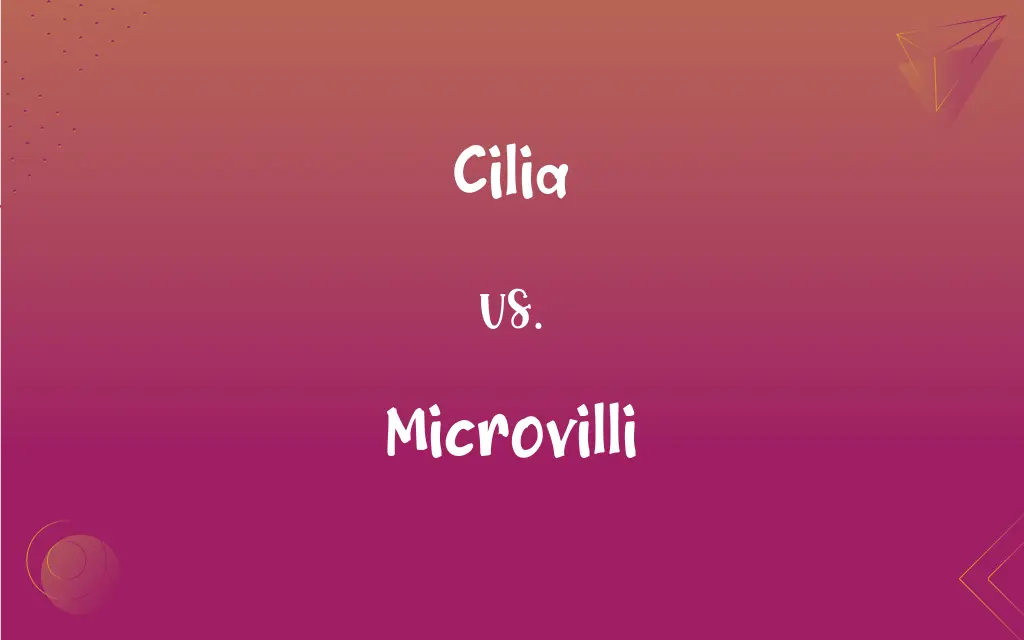Cilia vs. Microvilli: What's the Difference?
Edited by Janet White || By Harlon Moss || Updated on October 16, 2023
Cilia are hair-like structures that move to propel cells or move fluids, while microvilli are finger-like projections that increase surface area for absorption.

Key Differences
Cilia are slender, hair-like structures present on the surface of all mammalian cells. Microvilli, on the other hand, are tiny finger-like projections that can be found on the surface of certain cells, particularly those in the intestines.
The primary function of cilia is movement. They can either move cells or help move fluids over cellular surfaces. In contrast, microvilli do not aid in movement but play a vital role in increasing the cell's surface area, aiding in absorption.
Cilia are often longer than microvilli and can be found individually or in larger groups on cells. Microvilli, however, are typically found in large numbers, creating a brush-like border, especially evident on intestinal cells.
Structurally, cilia are complex and contain microtubules that aid in their movement function. Microvilli are simpler in structure, primarily consisting of actin filaments that maintain their shape.
Both cilia and microvilli are essential for the functioning of various cells. While cilia play a key role in the respiratory system by moving mucus and trapped particles, microvilli are indispensable for nutrient absorption in the digestive system.
ADVERTISEMENT
Comparison Chart
Primary Function
Movement (either of cells or fluids)
Increase surface area for absorption
Structure
Contains microtubules
Contains actin filaments
Location
Various cells (e.g., respiratory tract cells)
Certain cells (e.g., intestinal cells)
Appearance
Longer, hair-like structures
Shorter, finger-like projections
Movement Capability
Capable of movement
Do not move
ADVERTISEMENT
Cilia and Microvilli Definitions
Cilia
Tiny structures that aid in cellular locomotion.
The cilia on the single-celled organism propel it through water.
Microvilli
Small, finger-like projections that increase cellular surface area.
Microvilli on intestinal cells enhance nutrient absorption.
Cilia
Extensions on cells that can sense external signals.
The cilia detected changes in the surrounding fluid.
Microvilli
Cellular protrusions that play a role in increasing absorption.
Without microvilli, the efficiency of nutrient uptake would be reduced.
Cilia
Hair-like projections on cell surfaces involved in movement.
Cilia in our respiratory tract help move mucus and trapped dust.
Microvilli
Structures that amplify the membrane surface of absorptive cells.
Thanks to microvilli, cells can absorb nutrients more effectively.
Cilia
Motile structures that help transport substances over cell surfaces.
The movement of cilia ensures the even distribution of mucus.
Microvilli
Extensions on certain cells aiding in absorption and secretion.
The dense microvilli on the cell ensured efficient uptake of molecules.
Cilia
Cellular appendages important for motion and sensing.
Without functioning cilia, some cells cannot move or sense their environment properly.
Microvilli
Tiny projections on cells that increase their absorptive capacity.
The density of microvilli determines how well a cell can absorb substances.
Cilia
Plural of cilium.
Microvilli
Any of the minute hairlike structures projecting from the surface of certain cells, such as those lining the small intestine.
Cilia
Plural of cilium
Microvilli
Plural of microvillus
FAQs
Can cilia move on their own?
Yes, cilia are motile and can move.
Are cilia found in every cell?
No, cilia are not present in every cell; they're found in specific cells like those in the respiratory tract.
Do microvilli move like cilia?
No, microvilli are non-motile structures.
What makes cilia move?
Cilia contain microtubules that aid in their movement.
What's the main function of microvilli?
Microvilli primarily increase surface area to enhance absorption.
Are microvilli visible under a light microscope?
They're typically better observed under an electron microscope due to their small size.
Do all cells have microvilli?
No, only specific cells with absorption functions typically have microvilli.
How do cells benefit from having cilia?
Cilia can aid in cell movement, fluid movement, or sensing external environments.
Do microvilli play a role in secretion?
Yes, besides absorption, they can also be involved in secretion in some cells.
Why are cilia longer than microvilli?
Their length aids in their primary function of movement.
In which system of the body are microvilli most prominent?
The digestive system, especially the intestines, has cells with a high density of microvilli.
Can defects in cilia lead to diseases?
Yes, defects in cilia can result in conditions like primary ciliary dyskinesia.
Are microvilli only found in the intestines?
While prominent in intestines, microvilli can also be found in other cells with absorption functions.
How do cilia help in our respiratory system?
Cilia move mucus and trapped particles out of the respiratory tract.
Why are microvilli important for nutrient absorption?
They increase the cell's surface area, allowing more nutrients to be absorbed.
Are cilia and microvilli made up of the same proteins?
While both have cytoskeletal elements, cilia contain microtubules, and microvilli have actin filaments.
Can a cell have both cilia and microvilli?
While rare, some cells might have both, but they serve different functions.
What is the structural difference between cilia and microvilli?
Cilia have a complex structure with microtubules, while microvilli contain actin filaments.
Are microvilli ever motile?
No, microvilli are non-motile structures.
Do cilia and microvilli have a role in cell-to-cell communication?
While not their primary function, cilia can sense external signals, and microvilli can influence cell interactions.
About Author
Written by
Harlon MossHarlon is a seasoned quality moderator and accomplished content writer for Difference Wiki. An alumnus of the prestigious University of California, he earned his degree in Computer Science. Leveraging his academic background, Harlon brings a meticulous and informed perspective to his work, ensuring content accuracy and excellence.
Edited by
Janet WhiteJanet White has been an esteemed writer and blogger for Difference Wiki. Holding a Master's degree in Science and Medical Journalism from the prestigious Boston University, she has consistently demonstrated her expertise and passion for her field. When she's not immersed in her work, Janet relishes her time exercising, delving into a good book, and cherishing moments with friends and family.































































